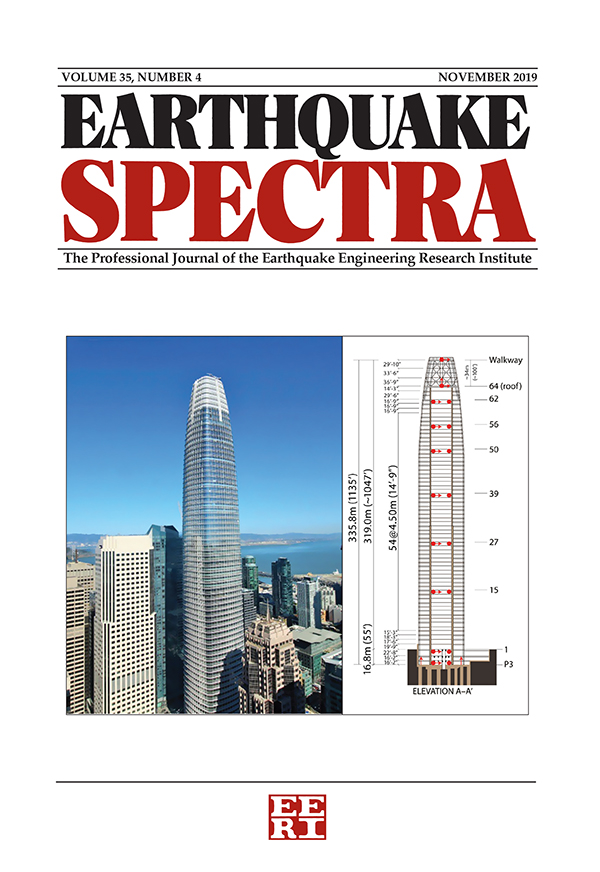2023 年美国国家地震灾害模型:俯冲地动模型
IF 3.7
2区 工程技术
Q2 ENGINEERING, CIVIL
引用次数: 0
摘要
美国地质调查局的国家地震灾害模型(NSHMs)用于计算地震地震动强度,以便对美国的结构进行设计和修复。美国大陆地区国家地震危险性模型的最新 2014 年版和 2018 年版包括对活动地壳和稳定地壳构造环境的地震动模型 (GMM) 的重大更新;但是,俯冲带 GMM 基本未变。随着最近新一代衰减-俯冲(NGA-Sub)地动模型的开发,以及最近在利用 "M9 "卡斯卡迪亚地震模拟方面取得的进展,我们现在可以使用改进的美国俯冲带和西雅图盆地地震动模型。新的 NGA-Sub GMM 支持多周期响应谱计算。它们提供了全球模型、卡斯卡迪亚特有的区域项以及考虑深盆地效应的项。本文重点介绍为在 2023 年国家高分辨率辐射计中实施而对俯冲 GMM 的更新,并将其与以往国家高分辨率辐射计的 GMM 进行比较。文章讨论了单个俯冲 GMM、其加权平均值以及相对于 2018 年 NSHM 对估计平均危害的影响。更新后的逻辑树包括三个新的 NGA-Sub GMM,并保留了两个旧模型,以表示所有相关时期地震动强度的中位数和标准偏差的认识不确定性。NGA-Sub 中值模型的三点逻辑树进一步代表了认识上的不确定性。最后,在西雅图地区,根据最先进的 M9 卡斯卡迪亚地震模拟,对长周期的盆地放大系数进行了调整。与 2018 NSHM 相比,新模型增加了界面地震的短周期和短震源到现场距离的估计平均危险值,但在其他情况下则降低了危险值。在较松软的土壤上,与 2018 NSHM 相比,新模型导致普吉特低地盆地长周期的估计平均危险值下降,但该盆地西雅图深部短周期的估计平均危险值上升。本文章由计算机程序翻译,如有差异,请以英文原文为准。
The 2023 US National Seismic Hazard Model: Subduction ground-motion models
The US Geological Survey National Seismic Hazard Models (NSHMs) are used to calculate earthquake ground-shaking intensities for design and rehabilitation of structures in the United States. The most recent 2014 and 2018 versions of the NSHM for the conterminous United States included major updates to ground-motion models (GMMs) for active and stable crustal tectonic settings; however, the subduction zone GMMs were largely unchanged. With the recent development of the next generation attenuation-subduction (NGA-Sub) GMMs, and recent progress in the utilization of “M9” Cascadia earthquake simulations, we now have access to improved models of ground shaking in the US subduction zones and the Seattle basin. The new NGA-Sub GMMs support multi-period response spectra calculations. They provide global models and regional terms specific to Cascadia and terms that account for deep-basin effects. This article focuses on the updates to subduction GMMs for implementation in the 2023 NSHM and compares them to the GMMs of previous NSHMs. Individual subduction GMMs, their weighted averages, and their impact on the estimated mean hazard relative to the 2018 NSHM are discussed. The updated logic trees include three of the new NGA-Sub GMMs and retain two older models to represent epistemic uncertainty in both the median and standard deviation of ground-shaking intensities at all periods of interest. Epistemic uncertainty is further represented by a three-point logic tree for the NGA-Sub median models. Finally, in the Seattle region, basin amplification factors are adjusted at long periods based on the state-of-the-art M9 Cascadia earthquake simulations. The new models increase the estimated mean hazard values at short periods and short source-to-site distances for interface earthquakes, but decrease them otherwise, relative to the 2018 NSHM. On softer soils, the new models cause decreases to the estimated mean hazard for long periods in the Puget Lowlands basin but increases within the deep Seattle portion of this basin for short periods relative to the 2018 NSHM.
求助全文
通过发布文献求助,成功后即可免费获取论文全文。
去求助
来源期刊

Earthquake Spectra
工程技术-工程:地质
CiteScore
8.40
自引率
12.00%
发文量
88
审稿时长
6-12 weeks
期刊介绍:
Earthquake Spectra, the professional peer-reviewed journal of the Earthquake Engineering Research Institute (EERI), serves as the publication of record for the development of earthquake engineering practice, earthquake codes and regulations, earthquake public policy, and earthquake investigation reports. The journal is published quarterly in both printed and online editions in February, May, August, and November, with additional special edition issues.
EERI established Earthquake Spectra with the purpose of improving the practice of earthquake hazards mitigation, preparedness, and recovery — serving the informational needs of the diverse professionals engaged in earthquake risk reduction: civil, geotechnical, mechanical, and structural engineers; geologists, seismologists, and other earth scientists; architects and city planners; public officials; social scientists; and researchers.
 求助内容:
求助内容: 应助结果提醒方式:
应助结果提醒方式:


